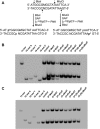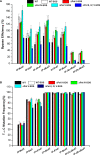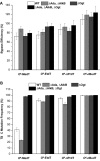Cytotoxic and mutagenic properties of O4-alkylthymidine lesions in Escherichia coli cells
- PMID: 26400162
- PMCID: PMC4678858
- DOI: 10.1093/nar/gkv941
Cytotoxic and mutagenic properties of O4-alkylthymidine lesions in Escherichia coli cells
Abstract
Due to the abundant presence of alkylating agents in living cells and the environment, DNA alkylation is generally unavoidable. Among the alkylated DNA lesions, O(4)-alkylthymidine (O(4)-alkyldT) are known to be highly mutagenic and persistent in mammalian tissues. Not much is known about how the structures of the alkyl group affect the repair and replicative bypass of the O(4)-alkyldT lesions, or how the latter process is modulated by translesion synthesis polymerases. Herein, we synthesized oligodeoxyribonucleotides harboring eight site-specifically inserted O(4)-alkyldT lesions and examined their impact on DNA replication in Escherichia coli cells. We showed that the replication past all the O(4)-alkyldT lesions except (S)- and (R)-sBudT was highly efficient, and these lesions directed very high frequencies of dGMP misincorporation in E. coli cells. While SOS-induced DNA polymerases play redundant roles in bypassing most of the O(4)-alkyldT lesions, the bypass of (S)- and (R)-sBudT necessitated Pol V. Moreover, Ada was not involved in the repair of any O(4)-alkyldT lesions, Ogt was able to repair O(4)-MedT and, to a lesser extent, O(4)-EtdT and O(4)-nPrdT, but not other O(4)-alkyldT lesions. Together, our study provided important new knowledge about the repair of the O(4)-alkyldT lesions and their recognition by the E. coli replication machinery.
© The Author(s) 2015. Published by Oxford University Press on behalf of Nucleic Acids Research.
Figures





Similar articles
-
Translesion synthesis of O4-alkylthymidine lesions in human cells.Nucleic Acids Res. 2016 Nov 2;44(19):9256-9265. doi: 10.1093/nar/gkw662. Epub 2016 Jul 27. Nucleic Acids Res. 2016. PMID: 27466394 Free PMC article.
-
Syntheses and characterizations of the in vivo replicative bypass and mutagenic properties of the minor-groove O2-alkylthymidine lesions.Nucleic Acids Res. 2014;42(16):10529-37. doi: 10.1093/nar/gku748. Epub 2014 Aug 12. Nucleic Acids Res. 2014. PMID: 25120272 Free PMC article.
-
Cytotoxic and mutagenic properties of minor-groove O2-alkylthymidine lesions in human cells.J Biol Chem. 2018 Jun 1;293(22):8638-8644. doi: 10.1074/jbc.RA118.003133. Epub 2018 Apr 23. J Biol Chem. 2018. PMID: 29685891 Free PMC article.
-
Mass Spectrometry-Based Quantitative Strategies for Assessing the Biological Consequences and Repair of DNA Adducts.Acc Chem Res. 2016 Feb 16;49(2):205-13. doi: 10.1021/acs.accounts.5b00437. Epub 2016 Jan 13. Acc Chem Res. 2016. PMID: 26758048 Free PMC article. Review.
-
Postreplication repair mechanisms in the presence of DNA adducts in Escherichia coli.Mutat Res. 2011 May-Jun;727(3):104-22. doi: 10.1016/j.mrrev.2011.04.003. Epub 2011 May 5. Mutat Res. 2011. PMID: 21558018 Review.
Cited by
-
Mass spectrometry-based assays for assessing replicative bypass and repair of DNA alkylation in cells.RSC Adv. 2023 May 22;13(23):15490-15497. doi: 10.1039/d2ra08340j. eCollection 2023 May 22. RSC Adv. 2023. PMID: 37223415 Free PMC article. Review.
-
Cytotoxic and mutagenic properties of O6-alkyl-2'-deoxyguanosine lesions in Escherichia coli cells.J Biol Chem. 2018 Sep 28;293(39):15033-15042. doi: 10.1074/jbc.RA118.004676. Epub 2018 Aug 1. J Biol Chem. 2018. PMID: 30068548 Free PMC article.
-
Augmenting tomato functional genomics with a genome-wide induced genetic variation resource.Front Plant Sci. 2024 Jan 24;14:1290937. doi: 10.3389/fpls.2023.1290937. eCollection 2023. Front Plant Sci. 2024. PMID: 38328621 Free PMC article.
-
Translesion synthesis of O4-alkylthymidine lesions in human cells.Nucleic Acids Res. 2016 Nov 2;44(19):9256-9265. doi: 10.1093/nar/gkw662. Epub 2016 Jul 27. Nucleic Acids Res. 2016. PMID: 27466394 Free PMC article.
-
Replication studies of carboxymethylated DNA lesions in human cells.Nucleic Acids Res. 2017 Jul 7;45(12):7276-7284. doi: 10.1093/nar/gkx442. Nucleic Acids Res. 2017. PMID: 28531304 Free PMC article.
References
-
- Friedberg E.C., Walker G.C., Siede W., Wood R.D., Schultz R.A., Ellenberger T. DNA Repair and Mutagenesis. Washington, D.C: ASM Press; 2006.
-
- Ballschmiter K. Pattern and sources of naturally produced organohalogens in the marine environment: biogenic formation of organohalogens. Chemosphere. 2003;52:313–324. - PubMed
-
- Hecht S.S. DNA adduct formation from tobacco-specific N-nitrosamines. Mutat. Res. 1999;424:127–142. - PubMed
Publication types
MeSH terms
Substances
Grants and funding
LinkOut - more resources
Full Text Sources
Other Literature Sources
Research Materials
Miscellaneous

